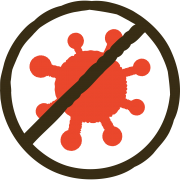AIHS Calls for Free Rapid Antigen Testing for Australia Workers and Stronger National COVID Workplace Guidance
/in COVID, Safety News /by adminHow much can software-based risk assessments save your business?
/in Risk Assessment /by adminIt makes sense to calculate just how much money you can save with risk assessment software before you sign up. So using our risk assessment productivity case study, we’ve calculated the savings for a business to be between $72.25 and $116.15 per worker, per month. Not too shabby. Under plant conditions these savings increase to between $144.50 and $231.63. Even better.
So far we’ve discerned that risk assessment forms take around 9-16 minutes to complete whereas with SafeWorkPro’s software alternative, the risk assessment workflow only took 4-8 minutes. That’s a time saving of 50 to 55 per cent! To get a better idea of the steps behind these savings, take a look at the below diagram that shows time-cost associated with the paper-based method.

The same workflow is used when using a software-based process compared to a paper-based process but the average time a reduced. From this we can determine a time saving per worker. The next diagram shows the average time spent on software-based risk assessments.

As you can see, risk assessment software offers massive time savings and as the old saying goes ‘time is money’. But before we get into the specifics of how we came to these figures it should be noted that the savings below do not take into account the cost of safety management software. Nonetheless the results are still great.
Let’s begin by calculating the time spent completing the risk management procedure for an individual worker every month.
Avg job time = 4 to 8 mins
Avg jobs per month = 20 jobs
Avg job time x avg jobs per month
= 4 to 8 mins x 20 jobs
= 1.3 to 2.6 hours per month
Depending on where the invoices and time sheets are considered, the costs will be on either the contractor’s business or the plant they work for. In these following calculations we include both costs to show a comparison but when you are doing your own cost analysis you must consider which business will be liable.
The average cost of a worker is:
Avg cost to business = $42.50/hour (Hour much you pay your workers)
Or
Avg cost to plant = $85/hour (How much you charge for your workers)
Therefore to calculate the amount of money spent in a month for a single worker:
Avg cost to business x hours per month
= $42.50 x 1.3 to 2.6
= $55.25 to $110.50 per month per worker
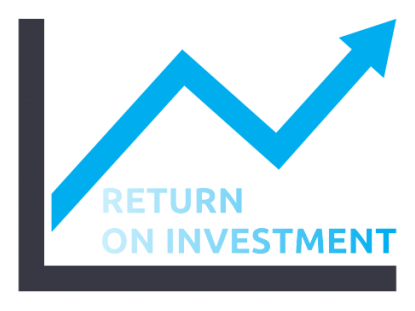
Or
Avg cost to plant x hours per month
= $85.00 x 1.3 to 2.6
= $110.50 to $221.00 per month per worker
What about the annual cost? The figures taken from our survey of a business that employed 12 workers indicate that:
Business cost per month per worker x number of workers x number of months
= $55.25 to $110.50 x 12 x 12
= $7,956.00 to $15,912.00 per year
Or
Plant cost per month per worker x number of workers x number of months
= $110.50 to $221.00 x 12 x 12
= $15,912.00 to $31,824.00 per year
For any business this is a lot of money. So what is the potential saving minus the cost of this health and safety management software?
Paper based business cost per year – software based business cost per year
= ($18,360.00 to $32,639.00) – ($7,956.00 to $15,912.00)
= $10,404.00 to $16,727.00 business savings per year
Or
Paper based plant cost per year – software based plant cost per year
= ($36,720.00 to $65,279.52) – ($15,912.00 to $31,824.00)
= $20,808 to $33,355.52 plant saving per year
For businesses this is a saving of $72.25 to $116.15 per worker, per year. Moreover this saves $144.50 to $231.63 for each worker a year.
The potential savings calculated here do not include the cost of the risk assessment system but considering OHS laws and regulations aren’t going anywhere, you should view software as an investment. Once you have established the cost of the software system you intend to use, you can calculate your return on investment (ROI). We think you’ll be pleasantly surprised. In the meantime you can read more about how SafeWorkPro’s job safety analysis software can cut your costs and boost productivity.
Risk Assessment Workflow for Construction Workers
/in Risk Assessment /by adminIn the hussle and bussle of high risk construction work, an independent contractor will be on several different sites in a month so having a firm understanding of the risk assessment worksheet is vital. At each construction site they must carry out several safety and risk management processes or face strict penalties. Below is a high-level diagram of the processes that construction contractors should carry out based on our risk assessment productivity case study.

1. Create Risk Assessment: Before starting any high risk construction work, a risk assessment must be conducted. Also known as a job safety analysis, risk assessments must include a safe work method statement (SWMS) and a risk assessment matrix.
2. Present to Foreman: The foreman or manager on the worksite must be presented with the risk assessment and SWMSs before work commences.
3. Conduct Work: All work should be conducted in a safe manner that complies with the safe operating procedures specified in the risk assessment.
4. Filing and Auditing: At the end of the day (or job) the risk assessments and SWMS’s should be filed and kept to pass any possible audits within the next 7 years.
There are two really good reasons why you should do risk assessments. First and foremost, they are designed to help keep your workmates safe. It is possible that a period of time will elapse between your team’s risk assessment training and its actual practice. So a risk assessment is a great way to remind your team of the inherent risks in high risk construction work and show them what risk management steps must be taken. The second reason you should do risk assessments is that you are legally required to. The Workplace Health and Safety Act 2011 states that before carrying out any high risk work you must do them or face strict fines and penalties.
So, where to from here? If you have a paper-based process in place, have a look at how much time and how much money this costs your business. Or if you are ready to tech-up and automate your process online then have a look at SafeWorkPro. Lets work safe Australia!
Hazard Assessment in Confined Spaces
/in Risk Assessment /by adminIn the previous article ‘Working in Confined Spaces Risk Assessment’, we looked at the definition of ‘confined space’ and what generic risks and hazards are associated with it. It is clear that confined spaces fall under the mandate of what constitutes high risk construction work. Based on the Work Health and Safety Regulation 2011, Safe Work Australia outlines many of the considerable hazards involving with working in confined spaces but there substantial details to each of these that should be noted.
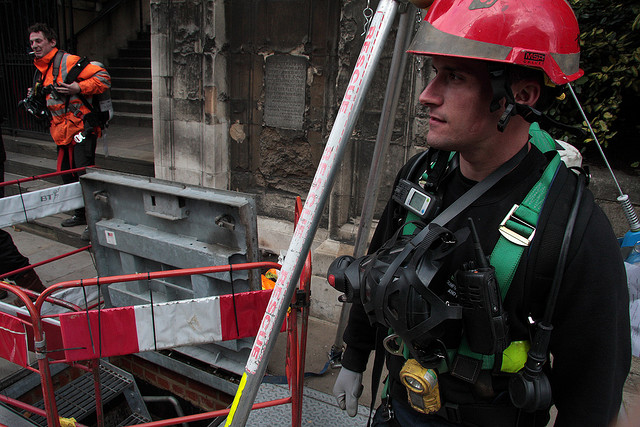
o Presence of harmful airborne contaminants
o Unsafe oxygen level caused when oxygen in the atmosphere is:
- displaced by gases produced during biological processes, for example, methane in a sewer
- displaced during purging of a confined space with an inert gas to remove flammable or toxic fumes
- depleted inside metal tanks and vessels through surface oxidation (for example, when rust forms)
- consumed during combustion of flammable substances
- absorbed or reacts with grains, wood chips, soil or chemicals in sealed silos.
- reacts with chemicals that increase risk of explosion or fire (eg hydrogen peroxide)
- leaks from oxygen tank or fitting during use of oxy-acetylene equipment
o Fire and explosion
- Flammable gas, mist or vapour in atmosphere exceeds 5% of its lower explosive limit (LEL)
- Evaporation of flammable residue
- Use of flammable materials
- Chemical reaction (eg build up methane from sewer)
- Presence of combustible dust (flour in silo)
o Introduction of an ignition source into atmosphere. Such sources may include:
- open flames and hot surfaces
- electrical equipment
- internal combustion engines
- metal tools striking metal surfaces
- spark-producing equipment for example grinding wheels
- static electricity
o Engulfment leading to asphyxiation
- Confined spaces with stored materials including plastics, sand, liquids, fertiliser, grain, coal, coal products, fly ash, animal feed and sewage
o Uncontrolled introduction of substances
- Substances include steam, water or other liquids, gases or solids that may result in a person drowning, being overcome by fumes or other harm
- Build up of exhaust fumes, including carbon monoxide, from nearby vehicles including LPG forklifts
o Contact with biological agents
- Such as micro-organism like virus, bacteria or fungi which can cause infectious diseases, dermatitis or lung conditions such as hypersensitivity pneumonitis
- Sewers, grain silos and manure pits are confined spaces where biological hazards may be present
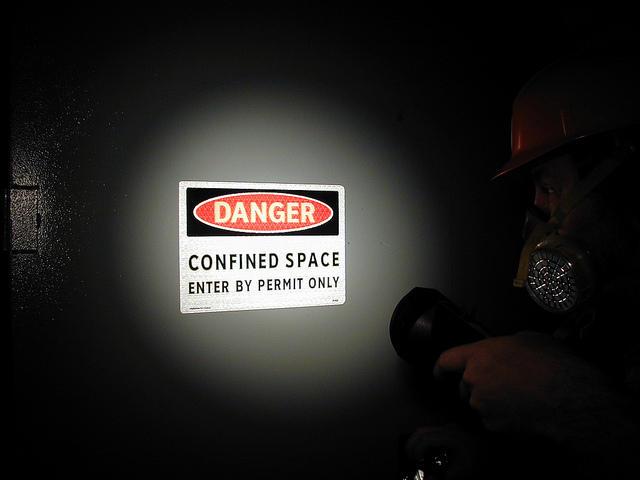
o Exposure to mechanical hazards
- The entanglement, crushing, cutting, piercing or shearing of parts of a person’s body from mechanical hazards including augers, agitators, blenders, mixers and stirrers
o Contact with electrical hazards
- Electrocution, shocks or burns caused by cables, transformers, capacitors, relays, exposed terminals and wet surfaces where electrical circuit and electrically powered plant are used
o Skin contact with hazardous substances
- Increased likelihood of skin contact with contaminated surfaces resulting in burns, irritation, allergic dermatitis or long-term systematic effects
o Noise
- Noise caused by plant, work method or process may be amplified due to noise reflections off hard surfaces
o Manual tasks
- Physical restraints of confined space may exacerbate hazards relating to manual tasks
- Further hazards may arise from use of PPE that restricts movement, grip and mobility
o Radiation
- Sources of radiation may include x-rays, lasers, welding flash, radio frequency and microwaves
o Environmental hazards
- Factors that contribute or cause harm such as heat or cold stress, inadequate lighting
- Slips, trips and falls
o Control methods for hazards near or adjacent to a confined space (pg 19)
- Hazards outside the confined space: ie vertical opening = risk of falling in space
- Traffic hazards should the confined space be located under or near a road
- Exhaust gas from a adjacent vehicle or machine may contaminate the confined area
- Confined areas adjacent to work involving flammable substances
Risk assessment for chemicals checklist
/in Risk Assessment /by adminWhen working with hazardous substances or chemicals, it is especially important to effectively complete risk assessments. One way to help in this area is to complete a risk assessment checklist before beginning any high risk construction work.
A hazardous substances risk assessment is a useful component of safe operating procedures but risk assessment checklists are a great way to double check any workplace precautions. This is beneficial due to the increased risks in construction presented by the potential long-term health effects of exposure to hazardous substances.
The below is a risk management checklist based on the codes of practices for managing risks of hazardous chemicals.
1: Does a risk assessment need to be carried out?
2: Has it been decided who will carry out the risk assessment?
3a: Have all the hazardous chemicals in the workplace been identified?
3b: Has a hazardous chemical register been produced?
· A register is a list of hazardous substances, accompanied by a safety data sheet, and easily accessed by all duty holders
4: Has information about the hazardous chemical been identified?
5a: Have other previous relevant records, including risk assessments, been checked?
· If yes: have any specific hazardous substances been assessed as high risk?
6: Does the hazardous substance have any health hazards?
7: Does the hazardous substance have any physicochemical hazards?
8: Does the hazardous substance have an exposure stands?
· Refer to Workplace Exposure Standards for Airborne Contaminants
9: Do workers involved in the work related to hazardous substances require health monitoring?
· Refer to Part 7.1, Div. 6 and Schedule 14 of the WHS Regulation 2011
10: Is there a potential for workers to be exposed to hazardous substances at the workplace including by-products and waste?
· Consider these questions:
o Is the substance released into the work area’s atmosphere?
o Are people located in the immediate vicinity?
o How long are workers exposed for?
o Are there risks involved in the storage and/or transportation of the hazardous substance?
11: Are the controls measures specified in the risk assessment effective in controlling hazards and reviewed regularly?
12: Are risks not significant, significant but adequately controlled, significant but not adequately controlled or uncertain?
13: Have any actionable safety procedures been conducted as a result of question 12?
14: Has the risk assessment been recorded for future reference?
Why Should You Keep Records of Risk Assessment Reports?
/in Risk Assessment /by adminThere are two answers to this question. First of all, creating safety culture within all aspects of the Australian workforce is the purpose of risk assessment. So by keeping records of completed risk assessments you have documents to refer back to for help with future health and safety tasks. This is useful for normalising a culture of workplace safety. The second reason for keeping risk assessment records is far more pragmatic.
The Work Health and Safety Act outlines the responsibilities duty holders have in creating and maintaining a safe workplace. Keeping records of risk assessments indicates potential compliance with these laws and can help ensure businesses do not get stung with hefty penalties.
Keeping records of the risk management process has many benefits. These include:
- Demonstrates to customers, clients, regulators and other business associates that health risks at work are being managed effectively
- A risk assessment review can be conducted more easily, resulting in greater business flexibility should OHS laws and regulations change
- Provides a base for preparing future safe operating procedures
- Allows more effective risk assessment training based on targeted goals
- Demonstrates how a person conducting a business of undertaking (PCBU) made risk management decisions
When keeping records of risk assessments, it’s useful to make special note of information like:
- Possible changes to either work practices or the workplace in general
- Any risk assessment training courses undertaken
- The parties that were consulted with during the risk management process
- When and how the risk assessment was implemented and reviewed
- The hazards and risks identified and the selected control methods
- Any complementary risk assessment forms including safety checklists, worksheets and risk assessment matrices

The scale and depth of maintaining risk assessment records may vary according to the size and nature of a business. In regards to a construction site risk assessment, there are certain requirements for how long risk assessments should be kept. Depending on the jurisdiction, risk assessment should be kept between five to seven years after a dangerous incident has taken place. Unless an incident has taken place, there is no minimum time period PCBU’s are required to keep records for but the practice is recommended nonetheless.
PCBU’s must also ensure all employees are aware of record keeping requirements including their locations and how to access them. For more information on record keeping for risk assessments read Safe Work Australia’s code of practice. Alternative you can read the SafeWorkPro Blog for answers to more basic risk assessment questions.
How much does paper-based risk assessments cost your business?
/in Risk Assessment /by admin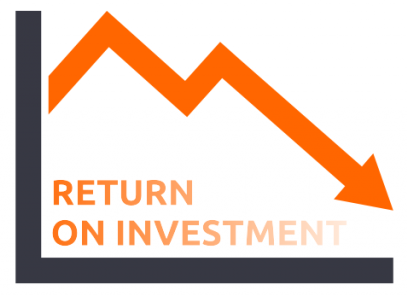
Every business risk is different but if you take an average value on the cost associated with each part of the risk analysis process, you’ll get a fair idea about how inefficient the paper-based method actually is. The data presented here was taken by surveying a construction business of 12 workers and represents a significant part of our broader risk assessment productivity case study. The average time spent on risk assessment processes per job is:
Avg job time = 9 to 16 mins (for more information in time calculations read here)
Avg no. of jobs per worker, per month = 20 jobs
Therefore to calculate the amount of time spent in a month for each worker:
Avg job time x avg jobs per month
= 9 to16 mins x 20 jobs
= 180 to 320 mins per month
= 3 to 5.3 hours per month
So we know that for a business of 12 workers, around three to five hours a month is spent completing risk assessment sheets. Depending on where the invoices and time sheets are considered, the costs will be on either the contractor’s business or the plant they work for. In these following calculations we include both costs to show a comparison. The average cost of a worker is:
Avg cost to business = $42.50/hour (Hour much you pay your workers)
Or
Avg cost to plant = $85/hour (How much you charge for your workers)
Therefore to calculate the amount of money spent in a month for a single worker:
Avg cost to business x hours per month
= $42.50 x 3 to 5.3
= $127.50 to $226.66 business cost per month, per worker
Or
Avg cost to plant x hours per month
= $85.00 x 3 to 5.3
= $255.00 to $453.33 plant cost per month, per worker
When you spread these numbers over a 12-month period, it becomes clear just how much money is spent conducting a risk assessment. For a construction contracting business in this survey that has 12 workers the annual cost is:
Business cost per month per worker x number of workers x number of months
= $127.50 to $226.66 x 12 x 12
= $18,360.00 to $32,639.00 per year
Or
Plant cost per month per worker x number of workers x number of months
= $255.00 to $453.33 x 12 x 12
= $36,720.00 to $65,279.52 per year
No matter how you change the numbers associated with your business there is no getting away from the underlying cost that a risk assessments and SWMS’s related processes have on your business. These approximate calculations do not include the time spent in administration of creating and maintaining a set of SWMS’s that a QTP (Qualified Trade Person) must sign-off. So, how can you reduce this cost? We believe the answer lies in business automation using software-based systems.

